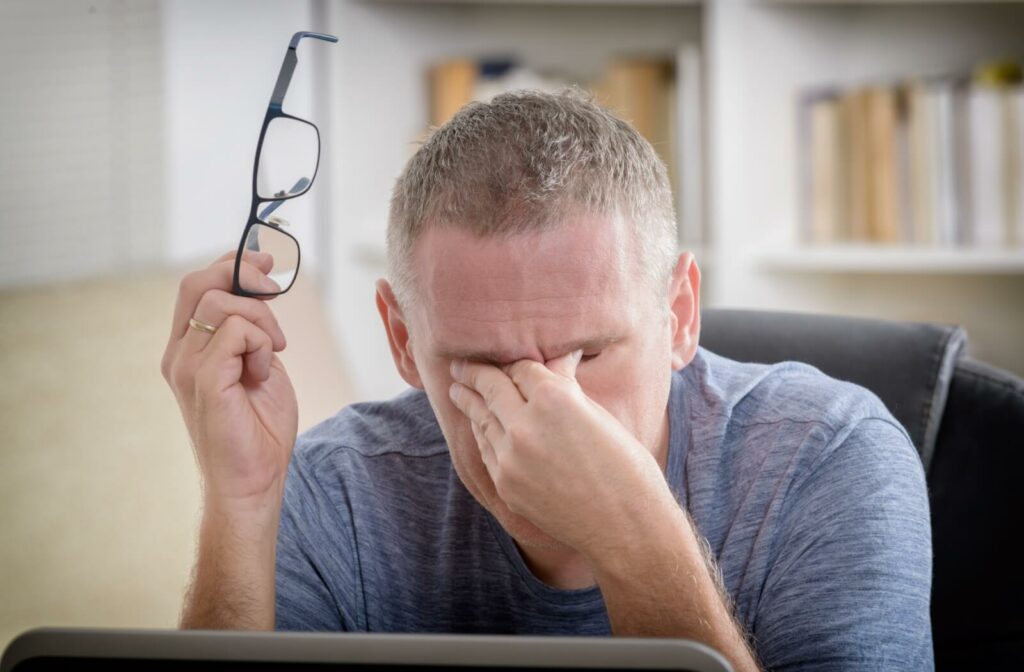That scratchy, gritty feeling in your eyes at the end of the day might be more than just tiredness. If you find yourself blinking constantly, trying to clear away blurriness that keeps returning, this is actually a common symptom of dry eye.
You may have dry eyes if you consistently experience symptoms like a gritty feeling in your eyes, redness, blurry vision, or even watery eyes. These signs suggest that your tears aren’t keeping the surface of your eye properly lubricated, which may mean that you need dry eye treatment.
Understanding your symptoms can help you figure out your next steps.
Common Signs & Symptoms of Dry Eye
You may have dry eye if you frequently experience uncomfortable symptoms in one or both eyes. Pay attention to how your eyes feel throughout the day, especially when you read or use a computer. The following symptoms are often a clue that something’s out of balance:
- A stinging, burning, or scratchy feeling
- Redness or irritation
- Sensitivity to light
- Watery eyes
- Stringy mucus near your eyes
- The sensation of having something in your eye
- Blurred vision or eye fatigue
- Difficulty with nighttime driving
- Discomfort when you wear contact lenses
What Causes That Dry, Irritating Feeling?
Healthy eyes have a steady supply of tears that create a protective layer called the tear film. This film has three layers:
- Oil
- Water
- Mucus
When these layers are out of balance, your tears may evaporate too quickly or not spread evenly across your eye. This can lead to the symptoms of dry eye disease.
Not Enough Tears
Sometimes, your eyes just don’t produce enough of the watery part of your tears. This can happen for several reasons. Age, certain health conditions, or even some medications can affect your ability to make a sufficient amount of tears.
Poor Quality Tears
Other times, your eyes make enough tears, but they lack the right amount of oil. Tiny glands in your eyelids, called the meibomian glands, produce this oil. If these glands become clogged, your tears evaporate too fast, leaving your eyes unprotected and feeling dry.
Factors That Increase Your Risk for Dry Eyes
Certain factors make it more likely for you to develop dry eye. While some can’t be changed, others can, and it helps to be aware. Here are the major contributors:
- Age: Tear production often decreases as we get older, particularly after age 50.
- Hormonal Changes: Women may experience dry eye due to pregnancy, menopause, or oral contraceptives.
- Environment: Exposure to wind, smoke, or very dry air can increase tear evaporation.
- Screen Time: You tend to blink less when you’re focusing on a computer or phone screen, which can lead to digital eye strain and dry out your eyes.
- Contact Lens Use: Long-term use of contact lenses can contribute to dry eye discomfort.
- Health Conditions: Conditions like rheumatoid arthritis, Sjogren’s syndrome, and thyroid disorders are linked to dry eye.

Conditions That Feel Like Dry Eye
Some eye conditions have symptoms that overlap with dry eye disease. This can make it tricky to figure out what’s really going on. That’s why an accurate diagnosis is so important for finding the right relief.
Eye Allergies
Itchy, watery, and red eyes are common to both conditions, as allergies can cause dry eyes by disrupting the tear film. However, allergies often come with other symptoms like sneezing or a stuffy nose. The triggers—like pollen or pet dander—are also different.
Blepharitis
Blepharitis is an inflammation of the eyelids. It can cause red, swollen eyelids and crusty eyelashes. It also creates the gritty, burning sensation that’s common with dry eye.
Your Guide to Relief with an Eye Doctor in Bridgeport
Figuring out the root cause of your eye discomfort is the first step toward feeling better. A visit to your eye doctor in Bridgeport can help you get clear answers and a plan to manage your symptoms. Together, we can find a solution that works for you.
A Comprehensive Eye Exam
During a comprehensive eye exam, I can look closely at your eyes, eyelids, and tear film. We can perform simple evaluations to measure the quantity and quality of your tears. This information helps us understand what’s causing your discomfort.
Professional Treatment Options
If at-home remedies aren’t enough, we can consider other professional treatment options. Some modern options focus on improving the function of your oil glands to provide more lasting relief. These can help restore the natural balance of your tear film.
- Intense Pulsed Light (IPL): This is a light-based therapy applied to the skin around the eyes to help reduce inflammation and improve gland function. You can learn more about IPL dry eye treatment and benefits during a consultation.
- Radiofrequency (RF) Treatment: This approach uses gentle heat to warm the eyelids, which can help melt blockages in the meibomian glands.
- Meibomian Gland Expression: This is a procedure where your eye doctor applies gentle pressure to the eyelids to clear out clogged oil glands.
Visit us for routine eye exams, trend-setting eyewear, and a welcoming touch that will make you and your family feel at home.
Book an appointment with our team at Precision Eye Care in Bridgeport to prioritize your eye health today.



